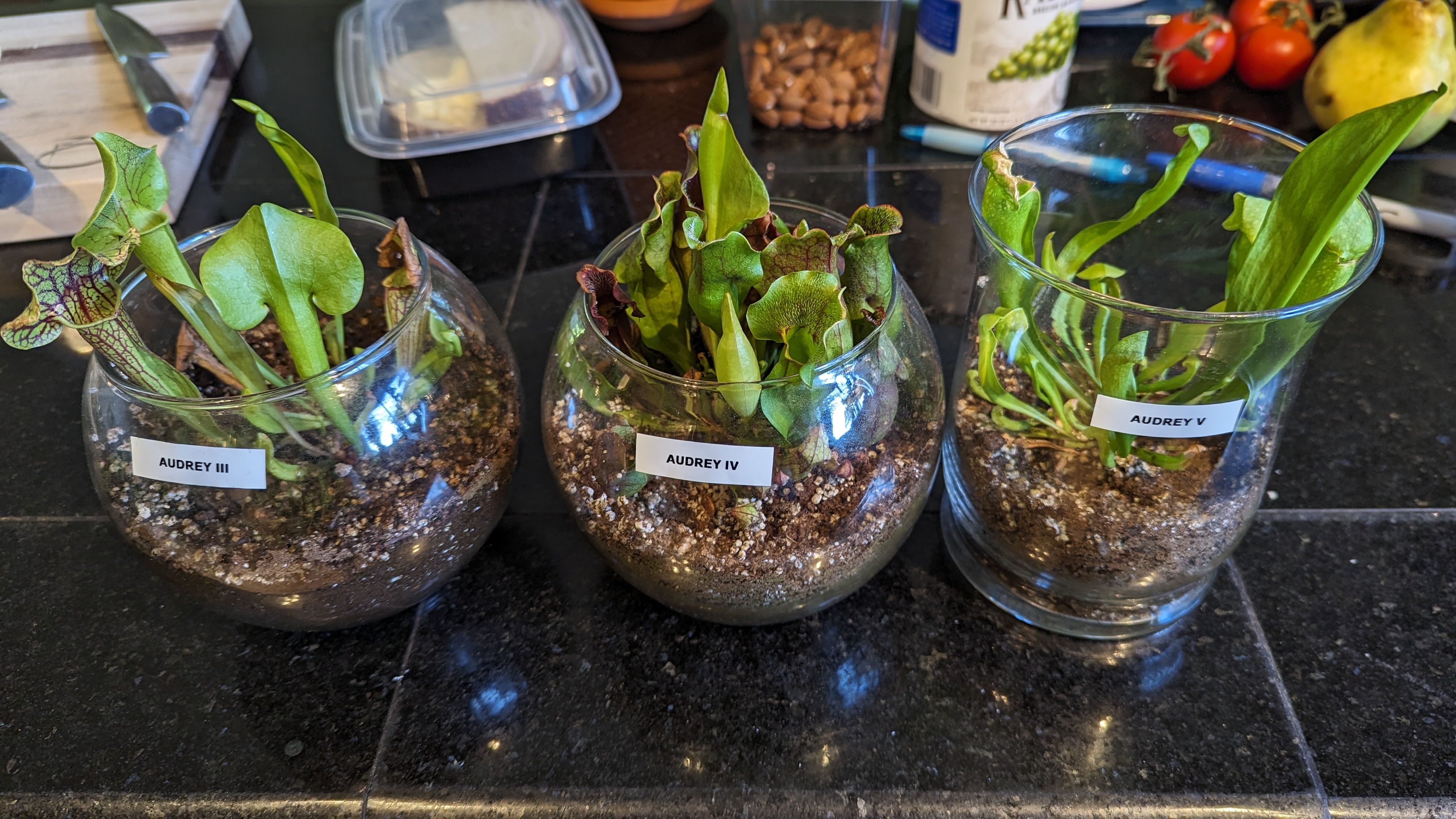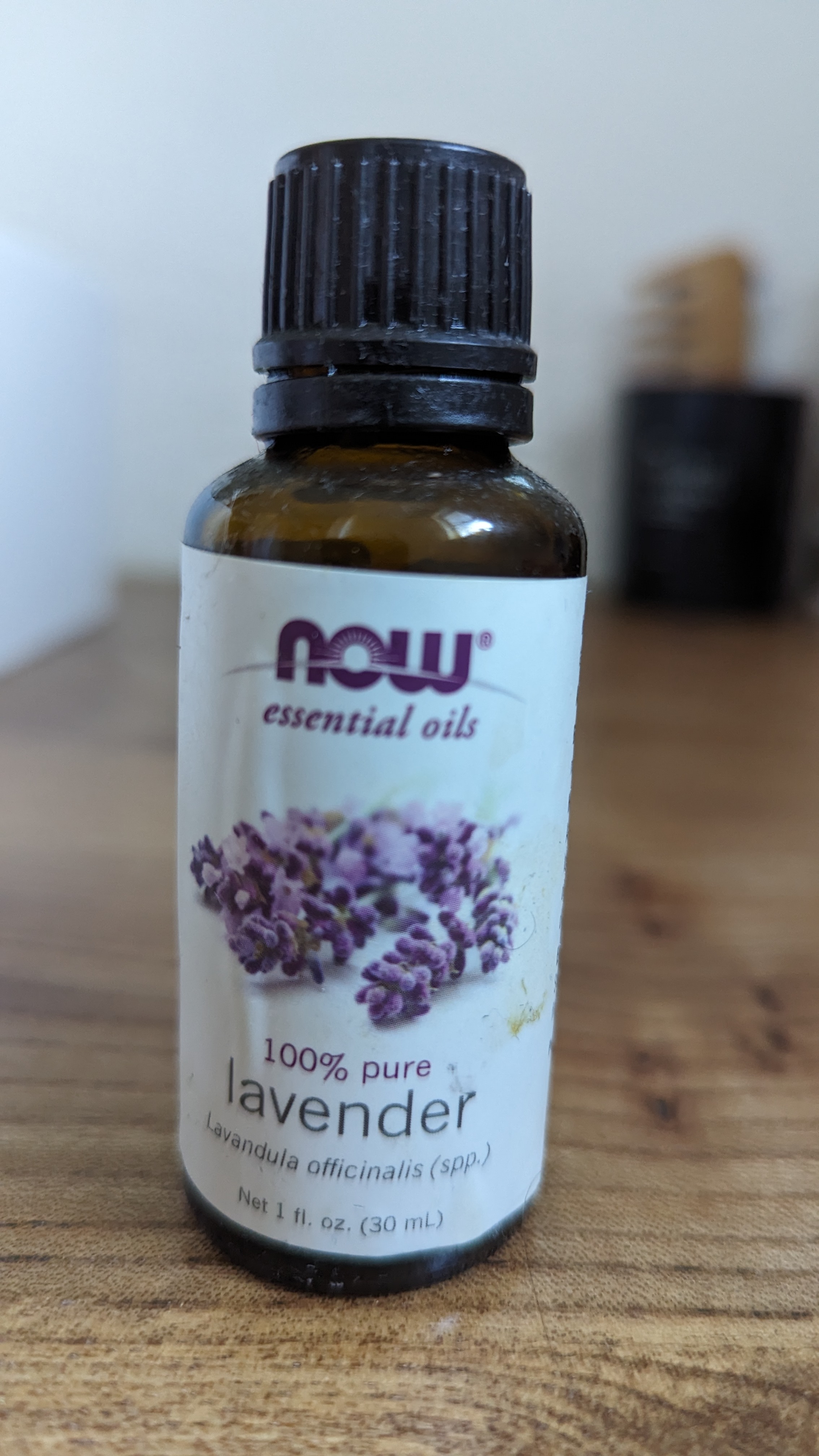Managing Kitchen Fruit Flies with a Little Shop of Horrors

I live in Seattle on a fairly wooded property. Every summer since we’ve moved here, we end up with swarms of fruit flies in the kitchen. They congregate around the compost bin and the fruit bowl (where there are always lots of bananas). We aren’t slobbish - I do the dishes and wipe down the counters every night, take the compost out and wash the bin 2-3x a week. Keeping everything washed and clean helps, but the fruit flies still build up over time. And if there’s even the slightest deviation from the cleaning schedule, within 2-3 days the fruit flies have built up exponentially and there are 50-100 of them swarming around.
Our previous remedy, iterated on and honed over years, was to leave a few traps out. We found what worked best was a short, wide brimmed glass (or tuppaware container) with a little bit of wine, a splash of apple cider vinegar, a drop of dish soap, then hit it with a spray of hot water to get a lot of suds and bubbles. When the swarms were particularly bad, one of these traps could catch dozens overnight, but we had to refill and refresh them constantly and the mass-graves of floating fruit flies were somewhat unsightly.
Earlier this Spring I was reading about symbotic relationships between humans and nature, and that gave me an idea to try some carnivorous plants.
Venus Fly Traps are the most well known type of carnivorous plant. They have sensitive little trigger hairs in their leaves, and when a fly lands and disturbs one of the hairs, the two lobes snap shut to trap the fly. The plant digests the fly before opening back up, ready for its next meal. The downside is they can take a week or more to open back up! That’s not nearly high-volume enough to deal with my fruit fly problem.
Some additional research taught me about a more passive type of carnivorous plant called a “pitcher plant.” There are many varieties, but generally their leaves form tubes that are open on top. These tubes are full of liquid - a mixture of rainwater and digestive fluids. Flies are attracted to the scent, fly in, then fall into the liquid. They’re trapped there until they drown, then are slowly digested. The same pitcher can catch many, many flies, and even smaller pitcher plants can have between 6 and 12 pitchers.
These sounded perfect! I ran up to the local plant nursery and got three carnivorous “Pitcher plants.” I got two different varieties - which internet research suggests are a Purple Pitcher Plant (Sarracenia Purpurea) and what I think is a Sarracenia Leucophylla (but could be a Sarracenia Flava).
I named them Audrey III, Audrey IV, and Audrey V. They were about the size in the photos when I got them. They were mature enough to have 6-8 open pitchers, and were growing another 6-8 juvenile pitchers. Each plant was roughly $10 each.
I’ve been disappointed by Audrey III and V’s performance (they’re either the Leucophylla or Flava species), but Audrey IV (the Purple Pitcher Plant) is a beast. These days I see one fruit fly buzzing around sometimes, but never more than that. When I look in Audrey IV’s pitchers, she’s been busy - just now I counted ten or eleven fruitflies and two house flies.
Passive countermeasures like Audrey IV works great because it prevents them from going exponential. If you’re taking fruit flies out early and continuously, they don’t have a chance to reproduce. A female fruit fly starts mating 8 hours after it emerges from the larval state, and lays about 400 eggs, which take 12-15 hours to hatch at typical room temperature. Needless to say - you gotta keep these under control!
 I did notice for a time they were still congregating by the compost and weren’t being drawn to Audrey’s sweet scents. More internet research seemed to indicate they didn’t like don’t like the smell of lavender, so I cut some lavender flowers and put them between the compost bin’s lid and filter. That didn’t seem to be effective, so I spritzed some much higher density lavender essential oil on the compost bin filter. Later that night I watched as a fly kept going into the holes in the lid, then back out, then in, but then back out. It didn’t like the smell! Success!
I did notice for a time they were still congregating by the compost and weren’t being drawn to Audrey’s sweet scents. More internet research seemed to indicate they didn’t like don’t like the smell of lavender, so I cut some lavender flowers and put them between the compost bin’s lid and filter. That didn’t seem to be effective, so I spritzed some much higher density lavender essential oil on the compost bin filter. Later that night I watched as a fly kept going into the holes in the lid, then back out, then in, but then back out. It didn’t like the smell! Success!
Since then, there’s been no congregation of fruit flies around the compost. I still see one or two flying around the kitchen, but Audrey IV is keeping them under control.
So that’s my official two-part recommendation for managing fruit flies: get yourself an Audrey IV and spritz some lavender essential oil on your compost bin filter to keep them out.
Taking care of a Pitcher Plant
A few notes on taking care of your new Audrey.
- You have to use distilled water. If you water them with sink water they’ll be dead within a day or two. These plants evolved in swampy, very nutrient-poor soils (that’s why they evolved to get their nutrients from their prey). The minerals in sink water are enough to overwhelm and poison your pitcher plants.
- Damp, but not soaked, soil. When you water them, you want the soil to be damp but not waterlogged. Although you should look up the needs of your specific species of Audrey.
- Filling the pitcher. For certain types of pitcher plants, you’ll want to fill up their pitchers with (distilled) water. Some types of pitcher plants have an opening at the top without any sort of leaf covering it (like Audrey IV). These types of plants are designed to supplement their digestive juices with rain water they catch. Since it presumably doesn’t rain inside your house like it does outside, you’ll want to use an eye dropper or a straw to drip some distilled water into the pitchers. Generally try to fill them 3/4 of the way. If your pitcher plant has a “hood” - or part of the leaf that’s covering the opening - that’s designed to shield it from the rain and you may not need to fill it up. Look up your particular species for specific instructions.
- Hand-feeding your pitcher plant. Outside of fruit fly season, you’ll want to feed your pitcher plant a snack every so often. I use dehydrated mealworms or bloodworms from the pet food store (typically used to feed reptiles, etc). Use tweezers to grab one and drop it into a pitcher. Keep an eye on how fast they digest to figure out the optimal feeding schedule for your plant - but it’s probably going to be close to 3-4 per plant once every 2-3 weeks.
